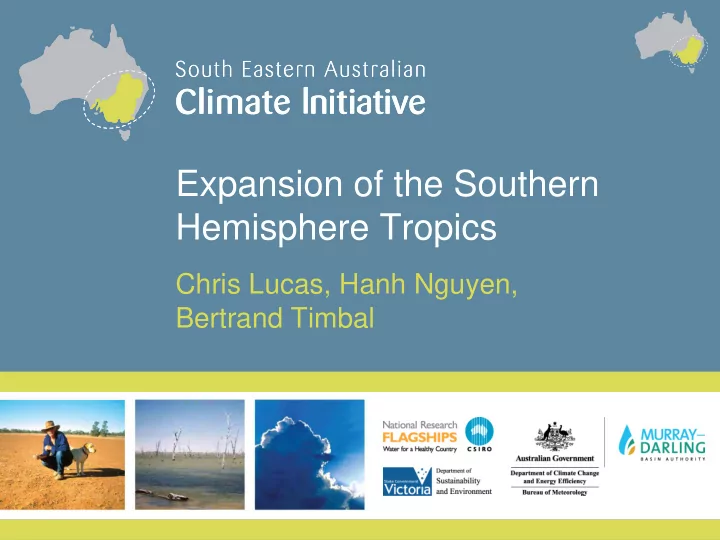

Expansion of the Southern Hemisphere Tropics Chris Lucas, Hanh Nguyen, Bertrand Timbal
Introduction • Improve understanding of nature and causes of climate variability and change in SE Australia (SEA) • Our project examines the dynamics of rainfall decline in SEA (and other subtropical regions) • Relate observed changes in mean meridional circulation (MMC) to this decline – Comprehensive review paper
What is the MMC? • Isobaric view – ‘Three-cell’ model – Hadley Cell – Ferrel, Polar cells • Isentropic view – Coordinate system tilted in ET – Single hemispheric circulation surface – Extratropics stronger images: ERA-40 Atlas
Idealized Model of MMC • Main features : Hadley Circulation and Polar Front – Annular mode is variability of polar front • Subtropics are region of mixing between the two – Tropical/extratropical interaction; Baroclinic waves important • Spatial variability driven by continents, SST, mountains • MMC not a ‘top-down’ driver; rather represents the cumulative effects of smaller scale processes
Observed Changes to the MMC • Both the tropical and extratropical portions of the MMC are changing – Annular mode increase = mean poleward shift in storm track position – Expansion of tropics or a widening of the Hadley Cell • Idealized model suggests these are related, but exact mechanisms are unclear – Baroclinic eddies clearly important – Important for subtropics (like SEA)!
Widening of the Tropics • Variety of studies have identified a global expansion of the tropics in multiple data sources – Ozone (Hudson 2006) – Satellite temperature trends and OLR (Fu et al. 2006; Hu and Fu 2007) – Reanalysis : jet streams trends (Archer and Calceira 2008), streamfunction trends (Hu and Fu 2007), tropopause height frequency (Seidel and Randel 2007; Birner 2010) • More widening in SH • Typically, SH trends of 0.5 to 1.0 degrees per decade since 1979, some higher
Analysis of Tropical Expansion • Examine SH widening of tropics directly from radiosonde data using a regional perspective • Data from Integrated Global Radiosonde Archive – Australia/ New Zealand – high data quality – South America – marginal data quality • Time period: 1989 – 2009 • Use data to accumulate tropopause statistics – height, pressure, temperature – WMO ‘lapse rate‘ definition • Annual tropopause height frequency
The Edge of the Tropics each dot is one observation of the tropopause, bin size = 1 km, centred
Analysis Method • Calculate time series of number of days with ‘tropical’ tropopause at each station • Average into zonal bands, generally 3-5 degrees. Nine bands in ANZ • Contour number of days per year in latitude/time • Slope of contours indicates trends
Mean Tropopause Height Frequency Tropical Tropopause Extratropical Tropopause Bimodal Distribution ANZ
Temporal Variability Slope of lines indicates an expansion of 0.4 to 0.8 degrees per decade
Comparison with Reanalyses Reanalysis data averaged over same bands and longitudes
South America • Similar to ANZ analysis • Data poorer quality, fewer stations, more missing data • 8 zonal bands, 3-6 degrees
SA Results and Comparison sonde results noisy, uncertain…but reanalyses are too… Suggested expansion greater
Discussion/Conclusions • Presentation of alternative model of MMC – unified hemispheric flow. – Subtropics defined by tropical-extratropical interaction • Regional analysis of tropical expansion from sonde data – Total amounts of expansion generally consistent with reported studies – Regional differences in expansion, but uncertain – Large and different interannual variability • Understanding regional differences demonstrated in these results could provide useful insights into future climate change, especially on a regional scale. – smaller scale processes matter for the larger flow – What is role of baroclinic eddies?
Recommend
More recommend